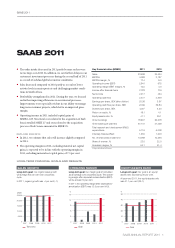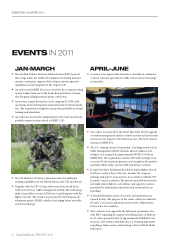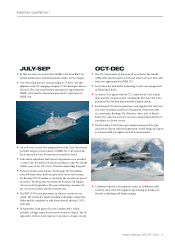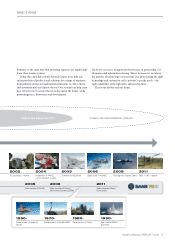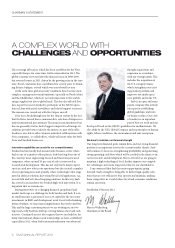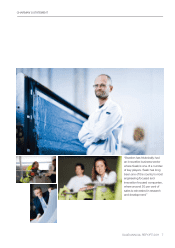Saab 2011 Annual Report Download - page 15
Download and view the complete annual report
Please find page 15 of the 2011 Saab annual report below. You can navigate through the pages in the report by either clicking on the pages listed below, or by using the keyword search tool below to find specific information within the annual report.
SAAB ANNUAL REPORT 2011 11
MARKET AND DRIVING FORCES
New security and functionality needs
Society today contains global ows of capital, goods and people
(ow society), which are strongly interdependent. As a result, major
crises can quickly spread through the system. is is exemplied
by the sovereign debt crisis, which is now threatening the nancial
system and global growth.
e trend toward a global ow economy has increased security
needs in the civil sector, creating greater demand for systems to
monitor and protect critical ows and hubs such as airports, ports,
railways, highways, and information and energy systems. As ICT,
information and communication technology, has become more im-
portant to society’s infrastructure, our vulnerability has increased.
ICT is also an important driver behind the integration of military
and commercial technology, where there is a growing overlap, espe-
cially in surveillance and control.
In times of limited resources, the focus is not only on security
but functionality and eciency. Customers in both military and
civil markets increasingly want broad-based, integrated solutions
that include more services: education, training, support and main-
tenance. Solutions are evaluated based on not only performance
but also in terms of cost of ownership and operation. e trend is
shiing toward full operational and functional commitments cover-
ing the entire lifecycle. Outsourcing of activities that had previously
been performed internally is becoming more common, including in
the military eld.
Reduced defence budgets and shift toward emerging countries
e decits and sovereign debts in many major Western economies
require comprehensive austerity programs, which are triggering
defence cuts. e U.S. and Canada accounted for the largest share
of global defence spending in 2010, approximately 43 per cent,
according to the Stockholm International Peace Research Institute
(SIPRI). e U.S. is expected to reduce its spending in the coming
years. e biggest increases in defence spending are in China and
other countries in Asia, and the trend going forward is expected
to favour emerging markets over traditional markets. Purchasing
habits have also changed. Demand is increasing for proven systems
that oer “more bang for the buck” and work in combination with
other systems.
New cooperation and alliances with a regional focus
International cooperation is important to ensure cross-border
ows and keep conict zones under control. e long-term trend
is still toward alliances for peacekeeping and economic develop-
ment purposes. Right now, however, it is toward regional alliances
and bilateral agreements. Moreover, large defence orders almost
always include extensive osets through industrial partnerships.
Large development projects are increasingly part of public-private
partnerships.
New conditions for R&D
International cooperation and system partnerships require open
systems that can be coordinated and integrated operationally. is
is why a growing share of development work is being done collabo-
ratively. As a result, the defence industry can expect less nancing
through national defence budgets, alongside the fact that shrinking
government budgets no longer allow for research and development
to the same extent as before. To a growing extent, defence authori-
ties around the world want access to the best the market has to oer
regardless of country of origin, and they want it delivered on short
notice. A larger share of research and development (R&D) therefore
has to be nanced by the industry itself. On the other hand, gov-
ernments around the world are devoting more research resources
to civil security, energy, the environment and sustainable urban
development. Access to energy is a critical factor in the develop-
ment of living standards and energy security and hence is central to
both military and civil strategies. Developing new sources of energy
is now a high priority in both old and new economies. e aim is
to become less dependent on undesirable and politically sensitive
sources, capitalise on the economic benets of new technology and
reduce global environmental risks. Development and security go
hand in hand in this area as well.
Local presence is decisive
Despite the trend toward international alliances, the need for a
strong local presence is critical to success in both the military and
civil markets. Customers want integrated solutions from compa-
nies that understand local conditions and can adapt their solutions
accordingly. is makes it important to be established locally, build
local competence and understand local conditions if you hope to be
successful. It signicantly increases your chances of being selected
as a supplier or subcontractor and to have a portion of your devel-
opment nanced through government appropriations.


